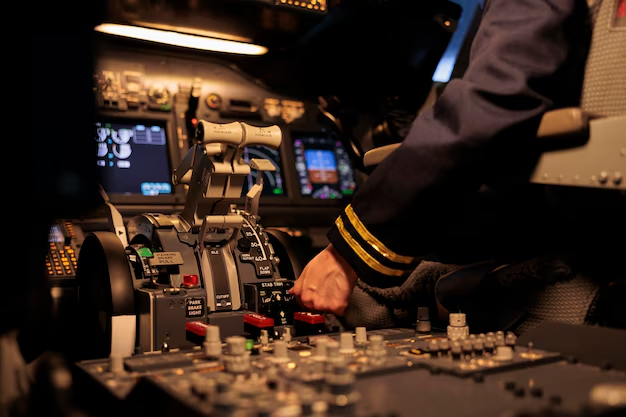In the rapidly advancing field of aviation, the integration of sophisticated communication protocols is crucial for enhancing aircraft performance and safety.
One such innovation is the ARINC (Aeronautical Radio, Incorporated) protocol suite, which has become a cornerstone of modern avionics systems. These protocols are essential for ensuring reliable data exchange and system interoperability in aircraft.
Among the many aircraft benefiting from ARINC protocols, the Boeing 737 stands out as a prime example of how these technologies contribute to enhanced flight control systems.
The Boeing 737, a workhorse of the commercial aviation industry, has undergone significant evolution over the years, with each iteration incorporating advanced technologies to improve performance, safety, and efficiency.
Central to these advancements is the integration of ARINC protocols, which play a pivotal role in streamlining communication between the aircraft’s various avionics components.
This article explores how ARINC protocols have been instrumental in the development and refinement of the Boeing 737’s flight control systems.
By delving into the specifics of these protocols and their application in the Boeing 737, we gain a deeper understanding of how they contribute to the aircraft’s enhanced capabilities and reliability.

Boeing 737 Flight Control Systems
The Boeing 737, one of the most popular and widely used commercial aircraft in history, has a sophisticated flight control system designed to ensure safe and efficient operation across various flight conditions. As the aircraft evolved through its different models—starting from the 737 Classic series to the Next-Generation (NG) and the latest 737 MAX—so did its flight control systems, incorporating advanced technologies and protocols to enhance performance and safety.
Overview of the Boeing 737’s Flight Control Architecture
The flight control system of the Boeing 737 is a complex network of components and subsystems that work together to manage the aircraft’s flight dynamics. Key elements of this system include:
- Flight Control Computers (FCCs): The heart of the flight control system, these computers process input from various sensors and pilot controls to manage the aircraft’s flight surfaces and systems. They ensure that the aircraft responds appropriately to pilot commands and maintains stability during flight.
- Actuators: These are devices that convert the electronic signals from the flight control computers into mechanical movements. Actuators control the aircraft’s primary flight surfaces, including the ailerons, elevators, and rudder, as well as secondary surfaces like flaps and slats.
- Hydraulic Systems: Hydraulic actuators are used to provide the necessary force for moving the flight control surfaces. The Boeing 737 employs multiple hydraulic systems to ensure redundancy and reliability.
- Sensors and Feedback Systems: Various sensors provide real-time data on the aircraft’s attitude, altitude, speed, and other critical parameters. Feedback systems relay this information to the flight control computers to adjust control surface positions and maintain optimal flight conditions.
Evolution of the Boeing 737 Flight Control Systems
- 737 Classic Series:
- Introduced in the late 1960s, the 737 Classic models (737-100/-200/-300/-400/-500) featured analog flight control systems. These early systems relied heavily on mechanical and hydraulic components, with limited digital integration.
- 737 Next-Generation (NG):
- The 737 NG series, introduced in the late 1990s, marked a significant advancement with the integration of digital flight control systems. The introduction of Fly-By-Wire (FBW) technology, although not fully implemented, brought about more precise and responsive control capabilities.
- Enhanced avionics, including improved flight management systems (FMS) and autopilot functionality, provided better navigation and flight performance.
- 737 MAX:
- The latest in the 737 series, the 737 MAX, incorporates advanced flight control systems that leverage cutting-edge technology. The MAX models feature the latest iteration of Fly-By-Wire technology, offering greater efficiency and control.
- Enhanced software algorithms and electronic systems ensure better performance and safety. The introduction of the Maneuvering Characteristics Augmentation System (MCAS) aims to improve the aircraft’s handling characteristics and prevent undesirable flight attitudes.
Key Components of the Flight Control Systems
- Primary Flight Control Systems: These systems manage the fundamental flight surfaces, such as ailerons, elevators, and rudder, to control the aircraft’s roll, pitch, and yaw.
- Secondary Flight Control Systems: These include flaps, slats, and spoilers, which are used to enhance the aircraft’s lift and drag characteristics during different phases of flight, such as takeoff and landing.
- Autopilot and Flight Management Systems (FMS): The autopilot system assists pilots by automating various flight functions, including altitude and heading control. The FMS integrates with the flight control systems to manage flight plans, navigation, and performance optimization.
Integration of ARINC Protocols in Boeing 737
The integration of ARINC (Aeronautical Radio, Incorporated) protocols into the Boeing 737’s avionics and flight control systems represents a critical advancement in modern aviation. These protocols facilitate efficient, reliable, and standardized communication between various aircraft systems and components, playing a pivotal role in enhancing the aircraft’s performance, safety, and operational efficiency.
Role of ARINC 429
ARINC 429 is a widely used protocol for data communication between avionics systems in aircraft. It operates as a point-to-point data bus that supports one-way data transmission from a single transmitter to multiple receivers.
- Data Exchange: ARINC 429 is employed extensively in the Boeing 737 to facilitate communication between flight control computers, sensors, and display systems. For instance, it transmits data from the aircraft’s various sensors, such as airspeed indicators and altitude sensors, to the flight control computers and cockpit displays.
- Reliability and Redundancy: The protocol’s design ensures high reliability and data integrity, which is crucial for flight safety. The use of ARINC 429 helps maintain consistent and accurate data exchange, even in complex systems with multiple interconnected components.
- Implementation: In the Boeing 737, ARINC 429 supports critical functions such as engine monitoring, flight parameter reporting, and system status updates. Its standardized format simplifies integration and ensures compatibility across different avionics systems and manufacturers.
Application of ARINC 664
ARINC 664, also known as the Aircraft Data Network (ADN) protocol, is a standard for Ethernet-based communication in aviation. It provides a framework for high-speed, reliable data exchange over a network.
- Network Communication: ARINC 664 enables the Boeing 737 to leverage Ethernet technology for efficient data transfer between various avionics systems. This protocol supports high-bandwidth applications, such as real-time flight data processing and complex avionics functions.
- Enhanced Connectivity: The adoption of ARINC 664 facilitates better integration of modern avionics systems and supports advanced features like real-time data streaming and networked avionics. This enhances the overall functionality and flexibility of the aircraft’s electronic systems.
- Implementation: In the Boeing 737, ARINC 664 is used in applications such as cockpit displays, flight management systems, and communication systems. It allows for seamless integration of new technologies and supports high-speed data exchange required for sophisticated flight control and navigation systems.
Use of ARINC 825
ARINC 825 is a protocol used for the Controller Area Network (CAN) bus, which is commonly used for in-cabin and maintenance data communication.
- Maintenance and Diagnostics: ARINC 825 facilitates communication between various onboard systems and maintenance tools. It supports diagnostics, system health monitoring, and troubleshooting, providing critical data to ground crews and maintenance personnel.
- System Integration: This protocol helps integrate onboard systems such as avionics and engine control systems with maintenance diagnostics tools, allowing for efficient data exchange and system analysis.
- Implementation: In the Boeing 737, ARINC 825 supports various maintenance and diagnostic functions, including data logging, fault detection, and system health monitoring. It enhances the ability to perform routine maintenance and address issues proactively.
Benefits Enabled by ARINC Protocols
- Improved Data Integrity: ARINC protocols ensure that data exchanged between aircraft systems is accurate and reliable, contributing to overall flight safety and performance.
- Enhanced System Interoperability: The standardized nature of ARINC protocols allows different avionics systems and components to communicate effectively, regardless of the manufacturer, ensuring seamless integration and operation.
- Increased Operational Efficiency: By streamlining data communication and enabling advanced functionalities, ARINC protocols enhance the operational efficiency of the Boeing 737, supporting both flight performance and maintenance processes.
- Support for Advanced Technologies: The use of ARINC protocols supports the integration of modern avionics technologies, such as advanced flight management systems and real-time data processing, contributing to the Boeing 737’s capability to meet current and future aviation demands.
Enhancements Enabled by ARINC Protocols
The integration of ARINC (Aeronautical Radio, Incorporated) protocols into aircraft systems has significantly advanced aviation technology, particularly in the Boeing 737. These protocols facilitate seamless communication between various avionics components, resulting in numerous enhancements across multiple dimensions of aircraft performance, safety, and operational efficiency.
Improved Data Integrity and Reliability
ARINC protocols are designed to ensure high levels of data integrity and reliability, which are crucial for the safe operation of modern aircraft.
- Consistent Data Transmission: ARINC protocols, such as ARINC 429 and ARINC 664, provide standardized formats for data exchange. This standardization minimizes the risk of data corruption or misinterpretation, ensuring that critical flight data, such as altitude, airspeed, and navigation information, is transmitted accurately and consistently.
- Error Detection and Correction: The protocols incorporate robust error-checking mechanisms to detect and correct data transmission errors. This capability is essential for maintaining the reliability of the aircraft’s avionics systems and preventing potential issues during flight.
Enhanced System Interoperability and Integration
ARINC protocols facilitate effective communication between various avionics systems and components, promoting interoperability and integration within the aircraft’s electronic ecosystem.
- Seamless Integration: By adhering to standardized communication protocols, different systems within the Boeing 737 can work together seamlessly. For instance, flight control computers, navigation systems, and cockpit displays can exchange information effortlessly, leading to more cohesive and integrated system performance.
- Compatibility Across Systems: The use of ARINC protocols ensures compatibility between avionics components from different manufacturers. This compatibility simplifies the integration of new technologies and upgrades, allowing for more flexible and scalable aircraft systems.
Contribution to Safety and Efficiency
The application of ARINC protocols contributes to both safety and operational efficiency, enhancing the overall performance of the Boeing 737.
- Enhanced Flight Safety: ARINC protocols support advanced avionics features that improve flight safety. For example, real-time data sharing between flight control systems and cockpit displays allows pilots to make informed decisions based on accurate and up-to-date information.
- Optimized Flight Performance: The ability to transmit and process data rapidly and reliably enables the Boeing 737 to optimize its performance during various flight phases. This includes better management of flight controls, more accurate navigation, and efficient engine performance.
- Advanced Monitoring and Diagnostics: ARINC protocols, such as ARINC 825, enhance the aircraft’s maintenance capabilities by providing detailed diagnostic information. This capability allows for early detection of potential issues, enabling proactive maintenance and reducing the likelihood of unexpected failures.
Real-World Examples of ARINC Protocols’ Impact
- Improved Flight Management Systems (FMS): The use of ARINC 664 in the Boeing 737’s FMS allows for high-speed data exchange and processing, leading to more accurate flight planning and navigation.
- Enhanced Cockpit Displays: ARINC 429 facilitates the transmission of critical flight data to cockpit displays, providing pilots with real-time information on aircraft performance, system status, and environmental conditions.
- Efficient Communication Systems: ARINC 825 supports efficient communication between avionics systems and maintenance tools, streamlining diagnostics and repair processes, and enhancing the overall reliability of the aircraft.
Future Implications
As aviation technology continues to advance, ARINC protocols are expected to evolve, incorporating new features and capabilities to address emerging needs and challenges.
- Support for Next-Generation Technologies: Future enhancements to ARINC protocols will likely support the integration of next-generation avionics systems, such as advanced autopilot systems, enhanced navigation capabilities, and more sophisticated communication networks.
- Adaptation to New Standards: ARINC protocols will continue to adapt to new industry standards and regulatory requirements, ensuring that they remain relevant and effective in supporting the latest advancements in aviation technology.
Conclusion
The integration of ARINC protocols into the Boeing 737’s avionics and flight control systems has been instrumental in advancing the aircraft’s performance, safety, and operational efficiency.
By providing standardized communication frameworks, ARINC protocols ensure reliable data exchange, enhance system interoperability and support the seamless integration of modern technologies.
These benefits have significantly contributed to the Boeing 737’s reputation as a reliable and high-performance aircraft in the commercial aviation industry.
As aviation technology continues to evolve, ARINC protocols will remain a key component in supporting next-generation avionics systems and meeting emerging industry demands.
Their role in improving data integrity, enhancing safety, and optimizing operational efficiency underscores the importance of standardized communication in modern aircraft.
The ongoing development and implementation of ARINC protocols will continue to drive innovations in aviation, ensuring that aircraft like the Boeing 737 remain at the forefront of technological advancement.





